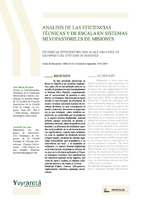Análisis de las eficiencias técnicas y de escala en sistemas silvopastoriles de Misiones
Technical efficiencies and scale analysis of silvopasture systems in Misiones
Abstract
Se han estudiado eficiencias en fincas en relación a sus variables explicativas y para ello se han utilizado datos de un estudio de productores que han implantado el Sistema Silvo Pastoril, conjuntamente con el convencional de potreros a cielo abierto en Misiones. Mientras que en aquel estudio se han evaluado las eficiencias de escala y técnicas aplicando Análisis de Envoltura de Datos, en esta investigación el modelo elaborado demuestra su importancia ya que incorpora como variables explicativas no controlables por el productor a la especie arbórea implantada. Además permite agregar existencia de piedras y pendiente del suelo, datos disponibles en la muestra. La diferencia de resultados logrados en la medición de la eficiencia técnica son significativos, y por lo tanto la hipótesis nula de igualdad de eficiencia técnica a lograr usando variables de entrada separadas (controlables por el productor y no controlables por éste) y no separadas es rechazada. La especie forestal implantada en la finca ha sido modelada en término de su peso en la eficiencia aplicando el Proceso Jerárquico Analítico. Son significativos los aumentos logrados en los ingresos por venta de carne y madera, al eliminar ineficiencias técnica y de escala en la finca. Efficiencies in farms have been studied in relation to their explanatory variables and for this, data from a study of producers who have implemented the Silvo Pastoril System, together with the conventional open-land paddocks in Misiones, have been used. While in that study the efficiencies of scale and techniques have been evaluated by applying Data Envelopment Analysis, in this investigation the elaborated model demonstrates its importance since it incorporates the implanted tree species as explanatory variables not controllable by the producer. It also allows adding the existence of stones and soil slope, data available in the sample. The difference in results achieved in the measurement of technical efficiency are significant, and therefore the null hypothesis of equality of technical efficiency to be achieved using separate input variables (controllable by the producer and not controllable by it) and not separated is rejected. The forest species implanted in the farm has been modeled in terms of its weight in efficiency applying the Analytical Hierarchical Process. The increases achieved in the income from the sale of meat and wood are significant, by eliminating technical and scale inefficiencies on the farm.
Collections
- Revista Yvyraretá [360]
The following license files are associated with this item:



